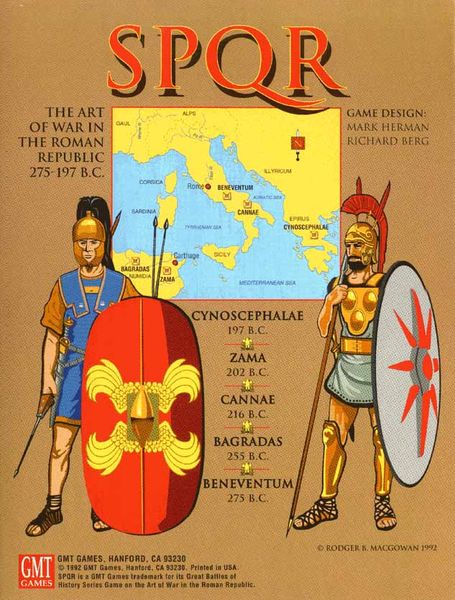SPQR is a historical wargame that was first released in in 1992. Designed by Rodger B. MacGowan and Mark Simonitch, this game is set in ancient Rome and allows players to recreate battles from this time period.
Game Components of SPQR
Maps: Two full-color, two-sided 22×34″ map sheets, each hex representing 70 yards of distance.Counters: 800 full-color, two-sided counters, including commanders, fighting units, and information markers.Scenario Booklets: Multiple scenario booklets, including historical battles like Cannae, Zama, Cynoscephalae, Beneventum, and Bagradas Plains.Player Aid Cards: Three player-aid cards for quick reference.Dice: Two 10-sided dice.Plastic Counter Storage Bags: For organizing the numerous counters.
How To Setup SPQR
Setting up SPQR involves selecting the desired scenario, placing the corresponding map sheet, and deploying the counters according to the scenario’s setup instructions. Each scenario has specific deployment rules, so players must carefully read and follow the scenario booklet. The game also includes player aid cards to help with rules and charts, making the setup process more manageable.
Gameplay Mechanics and Game Objective
Turn Structure: Turns are divided into phases, including leader activation, unit movement, firing, close combat, and administrative phases.Leader Activation: Leaders are activated based on their initiative ratings, allowing them to issue orders to units.Combat Resolution: Combat is resolved using cohesion points; units accumulate these points through fire and melee, and when they exceed the unit’s cohesion level, the unit breaks.Objective: The game is won by causing the enemy army to lose enough cohesion points to erode their overall morale and force them to withdraw from the battlefield.
Player Experience
SPQR is a medium-complexity wargame that offers a deep and immersive experience, especially for those interested in ancient warfare. The game can be played solo or with up to four players, and each scenario can take anywhere from a few hours to an entire afternoon to complete. The dynamic leader activation system and the need to manage unit cohesion add a layer of realism and strategy, making each game unique and challenging.
Pros
Historical Accuracy: SPQR is praised for its historical accuracy and detailed depiction of ancient battles.Dynamic Gameplay: The leader activation system and cohesion mechanics create a highly dynamic and unpredictable game environment.Versatility: The game can be played solo or with multiple players, and includes a variety of scenarios to keep gameplay fresh.Awards and Recognition: SPQR won several awards, including the 1992 Charles S. Roberts Award for Best Pre-World War II Boardgame and Best Wargame Graphics.
Cons
Complexity: The game is not suitable for entry-level wargamers due to its medium to high complexity level and extensive rulebook.Time Consumption: Larger scenarios can be quite time-consuming, potentially taking up to 8 hours to complete.
Personal Thoughts on SPQR
SPQR is an excellent choice for experienced wargamers and those with an interest in ancient military history. It is particularly suited for solo play, but also offers a compelling experience for multi-player sessions. However, it is not recommended for beginners due to its complexity. If you’re looking to dive into the Great Battles of History series, starting with smaller designs like *Hoplite* or *Cataphract* might be more approachable before moving to SPQR.
We are supported by our audience. When you purchase through links on our site, we may earn an affiliate commission, at no extra cost for you. Learn more.

